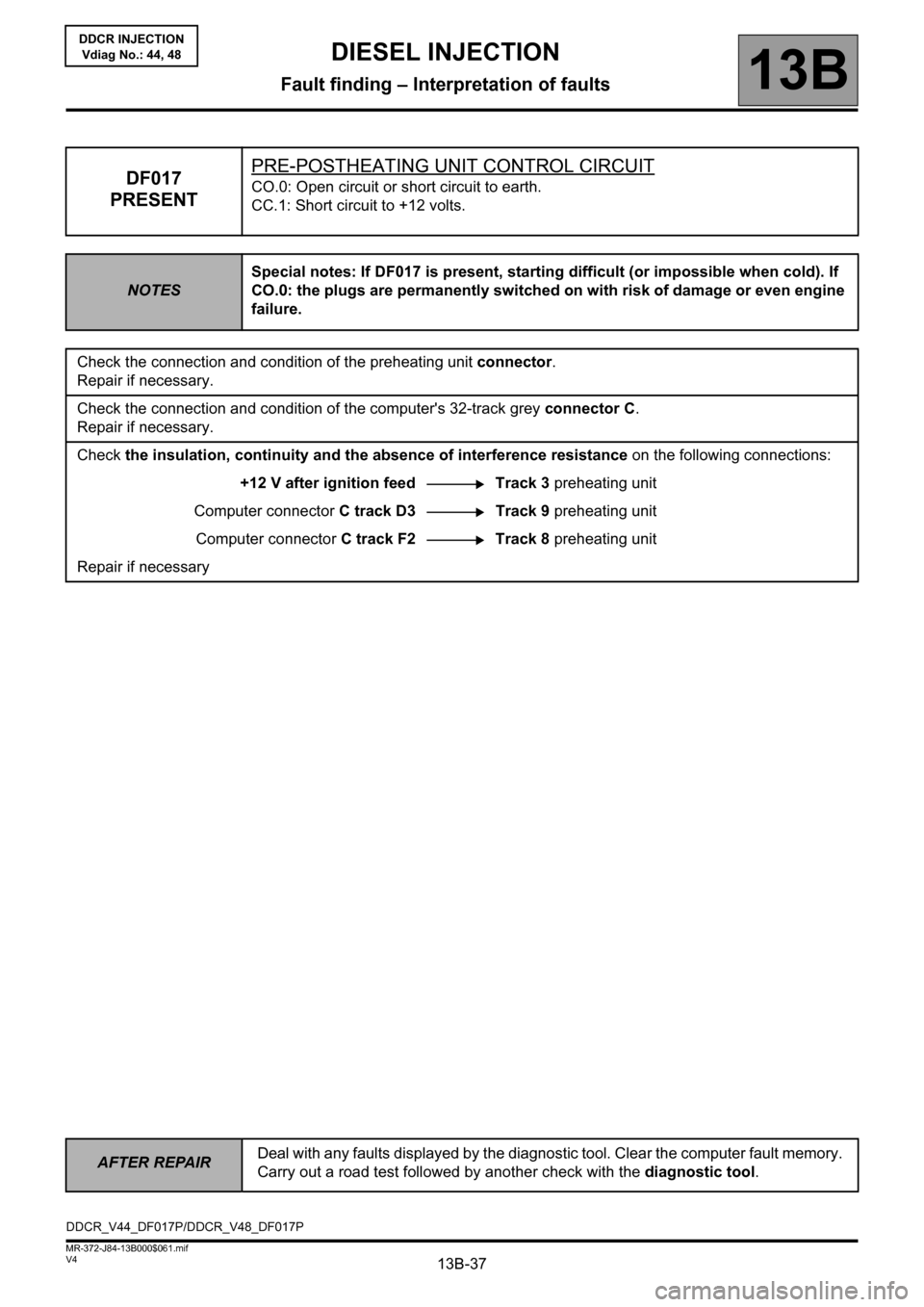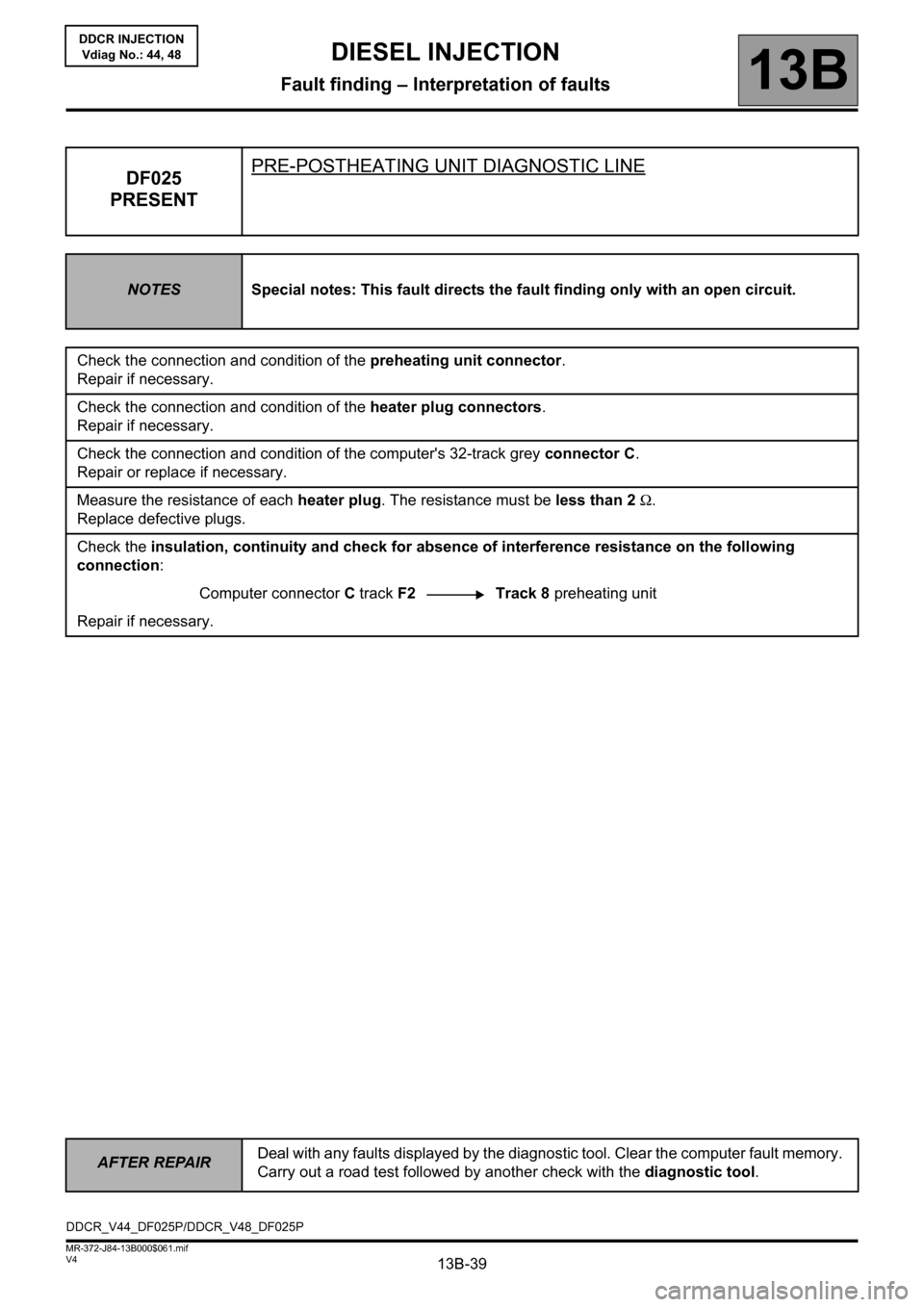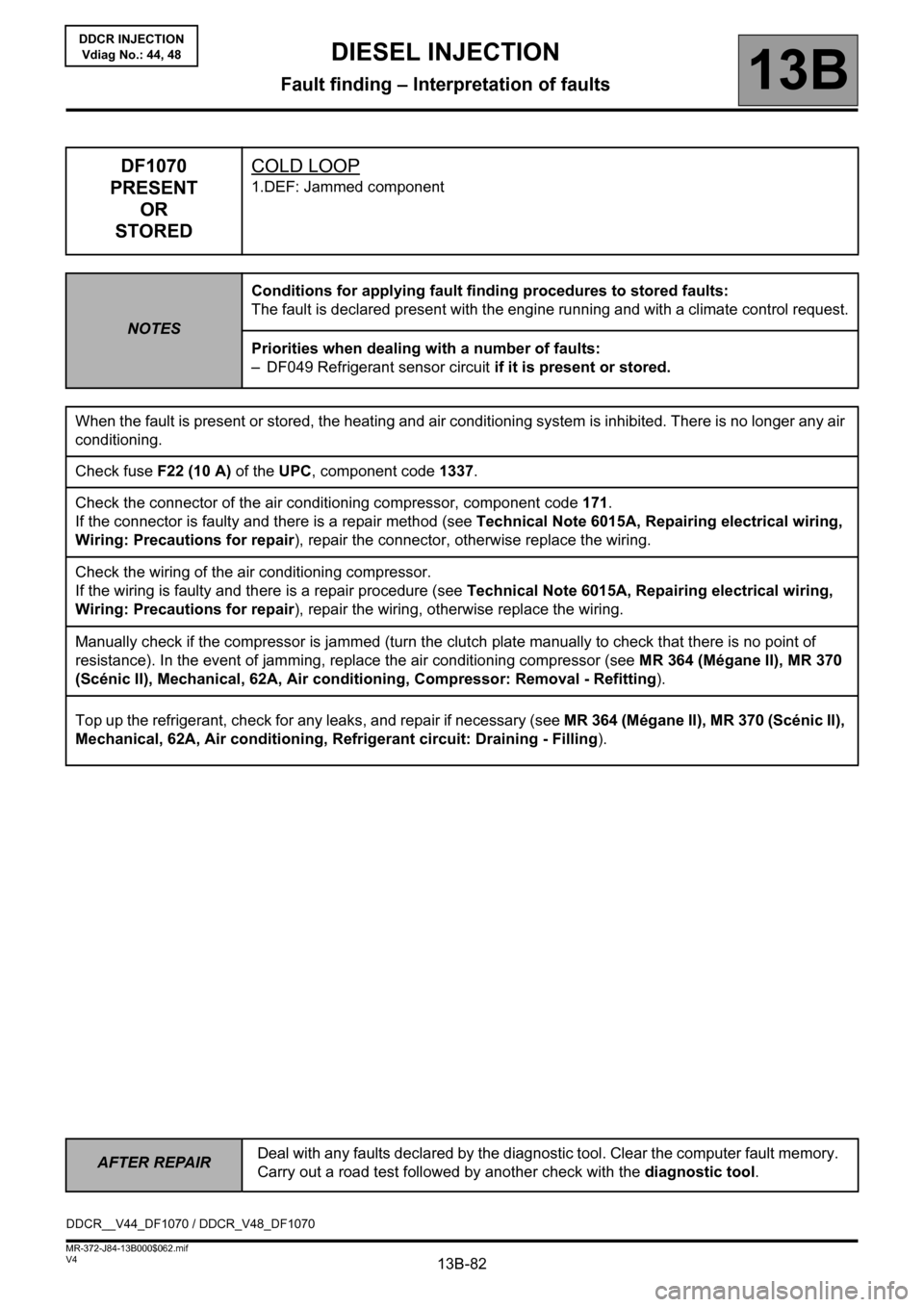Heat RENAULT SCENIC 2011 J95 / 3.G Engine And Peripherals Workshop Manual
[x] Cancel search | Manufacturer: RENAULT, Model Year: 2011, Model line: SCENIC, Model: RENAULT SCENIC 2011 J95 / 3.GPages: 198, PDF Size: 0.85 MB
Page 9 of 198

13B-9V4 MR-372-J84-13B000$020.mif
DIESEL INJECTION
Fault finding – System operation13B
DDCR INJECTION
Vdiag No.: 44, 48
Rail pressure check
The quality of combustion is influenced by the size of the atomised droplets in the cylinder. In the combustion
chamber, smaller fuel droplets will have time to burn fully, and will not produce smoke or unburned particles. To
meet the pollution requirements, the droplet size, and therefore the size of the injection holes, must be reduced.
With smaller holes, less fuel will be able to be introduced at a given pressure, which limits the power. To handle this
drawback, the injected fuel flow has to be increased, which means a pressure increase (and more apertures on the
injector nozzles). For the DDCR injection system, the pressure reaches 1400 bar in the rail, and must be constantly
regulated. The measuring circuit consists of an active pressure sensor on the rail connected to an analogue port on
the computer.
The High Pressure pump is supplied at low pressure (5bar) by a built-in transfer pump. This pump supplies the rail.
The rail filling pressure is controlled by the filling valve (IMV) and the discharge pressure is controlled by the injector
valves. This compensates for pressure drops. The filling actuator enables the high pressure pump to supply just
the exact quantity of diesel fuel required to maintain the rail pressure. This mechanism minimises the heat
generated and improves engine output.
In order to discharge the rail using the injector valves, the valves are actuated by short electrical pulses which are:
– short enough not to open the injector (and pass through the return circuit from the injectors),
– long enough to open the valves and discharge the rail.
The fuel surplus is sent back to the fuel filter or the tank, according to its flow. If there is no IMV control, the rail
pressure is limited by a discharge valve fitted on the pump.
Idling speed regulation
The computer handles the calculation of idling speed. This has to take account of the instantaneous power level to
be supplied, according to the following factors:
– Engine coolant temperature
– Gear engaged
– Battery charging
– Electrical consumers (Heating elements, Air conditioning, Fan assembly, Heated windscreen, etc.) active or
inactive
Individual injector correction (C2I)
The DDCR system injectors must be calibrated with corrective values to adjust their flow precisely. Each injector is
calibrated for different pressures on a test bench, and its specifications are shown on a label attached to the body of
the injector holders. These individual correction values are then written to the computer EEPROM, which can then
actuate the injectors by taking into account their manufacturing dispersion.
Page 11 of 198

13B-11V4 MR-372-J84-13B000$020.mif
DIESEL INJECTION
Fault finding – System operation13B
DDCR INJECTION
Vdiag No.: 44, 48
WITH FLOWMETER (K9K 728)
The flow of fresh air entering the engine is given by a hot wire ratiometric sensor. This flow sensor is used to
manage the amount of exhaust gas to be recirculated to ensure optimum recirculation rates. A fresh air temperature
sensor is built into the flowmeter.
Air flow measurement allows closed-loop control via the EGR valve.
Besides electrical faults with the sensor, there is a consistency test between the measured air flow and an estimated
air flow without EGR.
This flow evaluates the amount of fresh inlet air, based on the values supplied by the surrounding systems:
– the inlet air temperature measured by a sensor located after the turbocharger and/or after the intercooler (if fitted),
– the turbocharging pressure,
– the engine speed.
Pre-postheating actuation
Pre-postheating actuation consists of controlling the heater plugs and preheating warning light on the instrument
panel. The heater plugs are activated by relays, and the power is supplied from the battery. After the ignition is
switched on. Preheating is activated for a period of time. The warning light is illuminated for an activation period that
depends on the battery voltage, the atmospheric pressure, and the coolant temperature. When the temperature is
below a certain threshold, a postheating function can be used to improve the combustion stability, and consequently
engine operation (reducing unburnt particles and pollutant emissions).
Turbocharger control solenoid valve actuation
The turbocharger system comprises a solenoid valve that is used to actuate the vanes (or wastegate) to create an
overpressure or a vacuum in the inlet circuit.
Page 12 of 198

13B-12V4 MR-372-J84-13B000$020.mif
DIESEL INJECTION
Fault finding – System operation13B
DDCR INJECTION
Vdiag No.: 44, 48
Functions included
Air conditioning management assistance
For vehicles with air conditioning, the DDCR system can switch off the air conditioning under certain engine
operating conditions:
– when requested by the driver,
– when starting the engine,
– if the engine overheats (in order to reduce the power the engine has to supply),
– when the engine speed is kept at a very high level (to protect the compressor),
– during transition phases (e.g. under heavy acceleration when overtaking, anti-stalling and moving off strategies).
These conditions are only taken into account when they do not occur repeatedly, in order to prevent system
instabilities (erratic deactivations),
– when certain faults appear.
Cold loop air conditioning management
The air conditioning is the cold loop type and its management shared between several computers. The injection
computer is responsible for:
– managing demand for cold air according to the passenger compartment commands and the pressure value,
– determining the power absorbed by the compressor from the pressure,
– determining the fan unit commands according to vehicle speed and pressure.
The driver requests the air conditioning to be switched on by means of the ventilation selector coupled to a switch.
The cold air request is authorised or denied depending on the pressure measured. If this pressure is outside
the operating limits, the cold loop program is not activated.
Thermal regulation of the passenger compartment heating circuit
In a direct injection engine, fuel is injected directly into the combustion chamber. This leads to heat being lost
through the upper part of the engine and consequently, the cylinder head cooling circuit is smaller in size.
The effect of this is that the temperature of the coolant flowing through this circuit rises more slowly. However, this
coolant is also used by the passenger compartment heating system. In very cold conditions, it is therefore difficult to
achieve a comfortable passenger compartment temperature quickly.
To limit the time taken to warm up the system, air heating resistors, called RCHs, are fitted into the passenger
compartment heating circuit. The UCH decides whether the RCH are required, the UPC physically actuates
the RCH, and the injection computer determines whether to limit the power supplied to the RCH depending on
alternator charge, and also whether to disable them according to engine speed, load and vehicle speed. NOTE:
Fan unit actuation requests can be made by the injection computer, but these are sent on the CAN. These requests
depend on the air conditioning but also on the coolant temperature and vehicle speed.
Page 13 of 198

13B-13V4 MR-372-J84-13B000$020.mif
DIESEL INJECTION
Fault finding – System operation13B
DDCR INJECTION
Vdiag No.: 44, 48
Cruise control/speed limiter management:
When activated, the cruise control function maintains the vehicle at a preselected speed, regardless of the driving
conditions encountered. Using the control buttons, the driver can increase or decrease the vehicle speed.
The cruise control function can be deactivated either by using the control buttons or by switching off the cruise
control function selection switch, or when system events are detected such as depressing the brake or clutch
pedals, or when system errors are detected such as an inconsistent vehicle speed or excessive vehicle
deceleration. The cruise control function can also be temporarily suspended when the driver wants to resume
control of the vehicle and exceed the selected cruising speed by depressing the accelerator pedal which then
exceeds the selected fuel flow. The cruising speed is resumed when the driver releases the accelerator pedal.
The cruise control function can be reactivated and the last cruising speed can be resumed after deactivating
the function for whatever reason until the vehicle ignition is switched off (i.e. for as long as computer supply not cut
off). The vehicle will then attempt to return to the cruising speed using a controlled vehicle acceleration rate.
When switched on (using the selection switch), the vehicle speed limiter function limits the vehicle speed to a preset
value. The driver controls the vehicle in the normal way using the accelerator pedal until the limit speed is reached.
If an attempt is made to exceed this speed, the system will ignore the pedal request and will control the vehicle
speed as the cruise control function would do, provided that the driver continues to press the accelerator pedal.
As with the cruise control function, the set speed can be altered by adjusting the control buttons, with single touches
or holding down.
For safety reasons, the cruising speed can be exceeded by depressing the accelerator pedal beyond the pedal
position limiting value. Vehicle speed is then controlled using the accelerator pedal until the vehicle speed is
decreased to below the cruising speed, when the limiter function is activated again.
The driver has the following controls for the cruise control/speed limiter function:
– accelerator pedal,
– brake pedal,
– clutch pedal,
– function selector switch, used to select cruise control or speed limiter operating mode.
Instrument panel display
The computer displays certain information on the instrument panel relating to engine operation. This concerns 5
functions: the MIL (Malfunction Indicator Lamp) of the EOBD (European On Board Diagnostic), pre-postheating,
the coolant temperature, and engine faults: Level 1 (non-critical fault) and Level 2 (emergency stop). These five
functions are represented by 3 warning lights or messages displayed by the on-board computer.
Pre-postheating warning light
This light is used both as an in-operation indicator light and as a system fault indicator:
– permanently lit during + after ignition feed: indicates preheating of the heater plugs.
After preheating and an automatic timed 3 second off period, the warning light will come on if a Level 1 fault occurs
(leading to reduced operation and reduced safety levels. The driver should have repairs carried out as soon as
possible.)
Page 14 of 198

13B-14V4 MR-372-J84-13B000$020.mif
DIESEL INJECTION
Fault finding – System operation13B
DDCR INJECTION
Vdiag No.: 44, 48
Temperature / emergency stop warning light
This indicator light is used both as an in-operation indicator light and as a system fault warning light. It illuminates for
3 seconds when the power is switched on (automatic test procedure controlled by the instrument panel)
Continuously lit: indicates engine overheating or a Level 2 fault.
– if the fault reaches a critical level, the injection cuts off automatically after several seconds.
– in the event of engine overheating, it is the driver's choice to stop the car or continue driving.
ACTIVATION PROGRAMMING OF THE INSTRUMENT PANEL WARNING LIGHTS
Orange SERVICE warning light (level 1)
This warning light comes on, accompanied by the faulty injection message.
The driver should have the repairs carried out as soon as possible.
Red STOP warning light (level 2)
This warning light comes on, accompanied by the faulty injection message.
The driver should have the repairs carried out as soon as possible.
Excess pollution OBD ORANGE warning light:
This warning light is used to alert the driver of any injection faults that could lead to excessive pollution, or if
the EOBD system has been deactivated. The injection computer requests illumination of the OBD warning light for
a present fault only after three consecutive driving cycles.
The 3 second visual inspection when the ignition is switched on (automatic test procedure managed by
the instrument panel) is carried out by the injection computer.
Faults that activate the OBD warning light
Associated
faultTitle Specification
DF010 EGR position sensor circuit CC.1 - CO.0
DF016 EGR control circuit CC.1
DF026 Cylinder 1 injector control circuit CO – CC
DF027 Cylinder 2 injector control circuit CO – CC
DF028 Cylinder 3 injector control circuit CO – CC
DF029 Cylinder 4 injector control circuit CO – CC
DF038 Computer 3. DEF
DF114 EGR solenoid valve circuit 4. DEF
Page 17 of 198

13B-17V4 MR-372-J84-13B000$020.mif
DIESEL INJECTION
Fault finding – System operation13B
DDCR INJECTION
Vdiag No.: 44, 48
32-TRACK GREY CONNECTOR C
Description Tracks Tracks Description
Not used A1 E1 Not used
Water in diesel fuel detector earth A2 E2 Not used
Not used A3 E3 Not used
Not used A4 E4 Not used
Not used B1 F1 Supply relay control
Not used B2 F2 Preheating relay control
Water in diesel fuel detector signal B3 F3 Not used
Not used B4 F4 Not used
Not used C1 G1 Not used
Not used C2 G2 After relay + battery 1 earth
Refrigerant pressure sensor signal C3 G3 Refrigerant pressure sensor earth
Refrigerant pressure sensor supply C4 G4 Not used
Not used D1 H1 Potentiometer earth Gang 1
Not used D2 H2 Not used
Heater plug diag signal D3 H3 After relay + battery 2
Not used D4 H4 Not used
NOTE:
The supply voltage on tracks G2 and H2 is not measurable when the computer connector is disconnected.
Page 22 of 198

13B-22V4 MR-372-J84-13B000$050.mif
13B
DDCR INJECTION
Vdiag No.: 44, 48
Tool faultAssociated
DTCDiagnostic tool title
DF001 0115 Coolant temperature sensor circuit
DF002 0070 Air temperature sensor circuit (728, 729)
DF003 2226 Atmospheric pressure sensor circuit
DF005 0335 Engine speed sensor circuit.
DF007 0190 Rail pressure sensor circuit
DF008 0225 Pedal potentiometer circuit track 1
DF009 2120 Pedal potentiometer circuit track 2
DF010 0409 EGR position sensor circuit
DF014 0500 Vehicle speed information circuit
DF015 0685 Main relay control circuit
DF016 0403 EGR control circuit
DF017 0382 Preheating unit control circuit
DF024 0231 Low pressure actuator control circuit
DF025 0380 Preheater unit diagnostic connection
DF026 0201 Cylinder 1 injector control circuit
DF027 0202 Cylinder 2 injector control circuit
DF028 0203 Cylinder 3 injector control circuit
DF029 0204 Cylinder 4 injector control circuit
DF037 0513 Engine immobiliser
DF038 0606 Computer
DF039 0110 Inlet air temperature sensor circuit
DF047 0560 Computer feed voltage
DIESEL INJECTION
Fault finding – Fault summary table
Page 37 of 198

13B-37
AFTER REPAIRDeal with any faults displayed by the diagnostic tool. Clear the computer fault memory.
Carry out a road test followed by another check with the diagnostic tool.
V4 MR-372-J84-13B000$061.mif
DIESEL INJECTION
Fault finding – Interpretation of faults13B
DDCR INJECTION
Vdiag No.: 44, 48
DF017
PRESENTPRE-POSTHEATING UNIT CONTROL CIRCUITCO.0: Open circuit or short circuit to earth.
CC.1: Short circuit to +12 volts.
NOTESSpecial notes: If DF017 is present, starting difficult (or impossible when cold). If
CO.0: the plugs are permanently switched on with risk of damage or even engine
failure.
Check the connection and condition of the preheating unit connector.
Repair if necessary.
Check the connection and condition of the computer's 32-track grey connector C.
Repair if necessary.
Check the insulation, continuity and the absence of interference resistance on the following connections:
+12 V after ignition feed Track 3 preheating unit
Computer connector C track D3 Track 9 preheating unit
Computer connector C track F2 Track 8 preheating unit
Repair if necessary
DDCR_V44_DF017P/DDCR_V48_DF017P
Page 39 of 198

13B-39
AFTER REPAIRDeal with any faults displayed by the diagnostic tool. Clear the computer fault memory.
Carry out a road test followed by another check with the diagnostic tool.
V4 MR-372-J84-13B000$061.mif
DIESEL INJECTION
Fault finding – Interpretation of faults13B
DDCR INJECTION
Vdiag No.: 44, 48
DF025
PRESENTPRE-POSTHEATING UNIT DIAGNOSTIC LINE
NOTESSpecial notes: This fault directs the fault finding only with an open circuit.
Check the connection and condition of the preheating unit connector.
Repair if necessary.
Check the connection and condition of the heater plug connectors.
Repair if necessary.
Check the connection and condition of the computer's 32-track grey connector C.
Repair or replace if necessary.
Measure the resistance of each heater plug. The resistance must be less than 2 Ω.
Replace defective plugs.
Check the insulation, continuity and check for absence of interference resistance on the following
connection:
Computer connector C track F2 Track 8 preheating unit
Repair if necessary.
DDCR_V44_DF025P/DDCR_V48_DF025P
Page 82 of 198

13B-82
AFTER REPAIRDeal with any faults declared by the diagnostic tool. Clear the computer fault memory.
Carry out a road test followed by another check with the diagnostic tool.
V4 MR-372-J84-13B000$062.mif
DIESEL INJECTION
Fault finding – Interpretation of faults13B
DDCR INJECTION
Vdiag No.: 44, 48
DF1070
PRESENT
OR
STOREDCOLD LOOP
1.DEF: Jammed component
NOTESConditions for applying fault finding procedures to stored faults:
The fault is declared present with the engine running and with a climate control request.
Priorities when dealing with a number of faults:
– DF049 Refrigerant sensor circuit if it is present or stored.
When the fault is present or stored, the heating and air conditioning system is inhibited. There is no longer any air
conditioning.
Check fuse F22 (10 A) of the UPC, component code 1337.
Check the connector of the air conditioning compressor, component code 171.
If the connector is faulty and there is a repair method (see Technical Note 6015A, Repairing electrical wiring,
Wiring: Precautions for repair), repair the connector, otherwise replace the wiring.
Check the wiring of the air conditioning compressor.
If the wiring is faulty and there is a repair procedure (see Technical Note 6015A, Repairing electrical wiring,
Wiring: Precautions for repair), repair the wiring, otherwise replace the wiring.
Manually check if the compressor is jammed (turn the clutch plate manually to check that there is no point of
resistance). In the event of jamming, replace the air conditioning compressor (see MR 364 (Mégane II), MR 370
(Scénic II), Mechanical, 62A, Air conditioning, Compressor: Removal - Refitting).
Top up the refrigerant, check for any leaks, and repair if necessary (see MR 364 (Mégane II), MR 370 (Scénic II),
Mechanical, 62A, Air conditioning, Refrigerant circuit: Draining - Filling).
DDCR__V44_DF1070 / DDCR_V48_DF1070